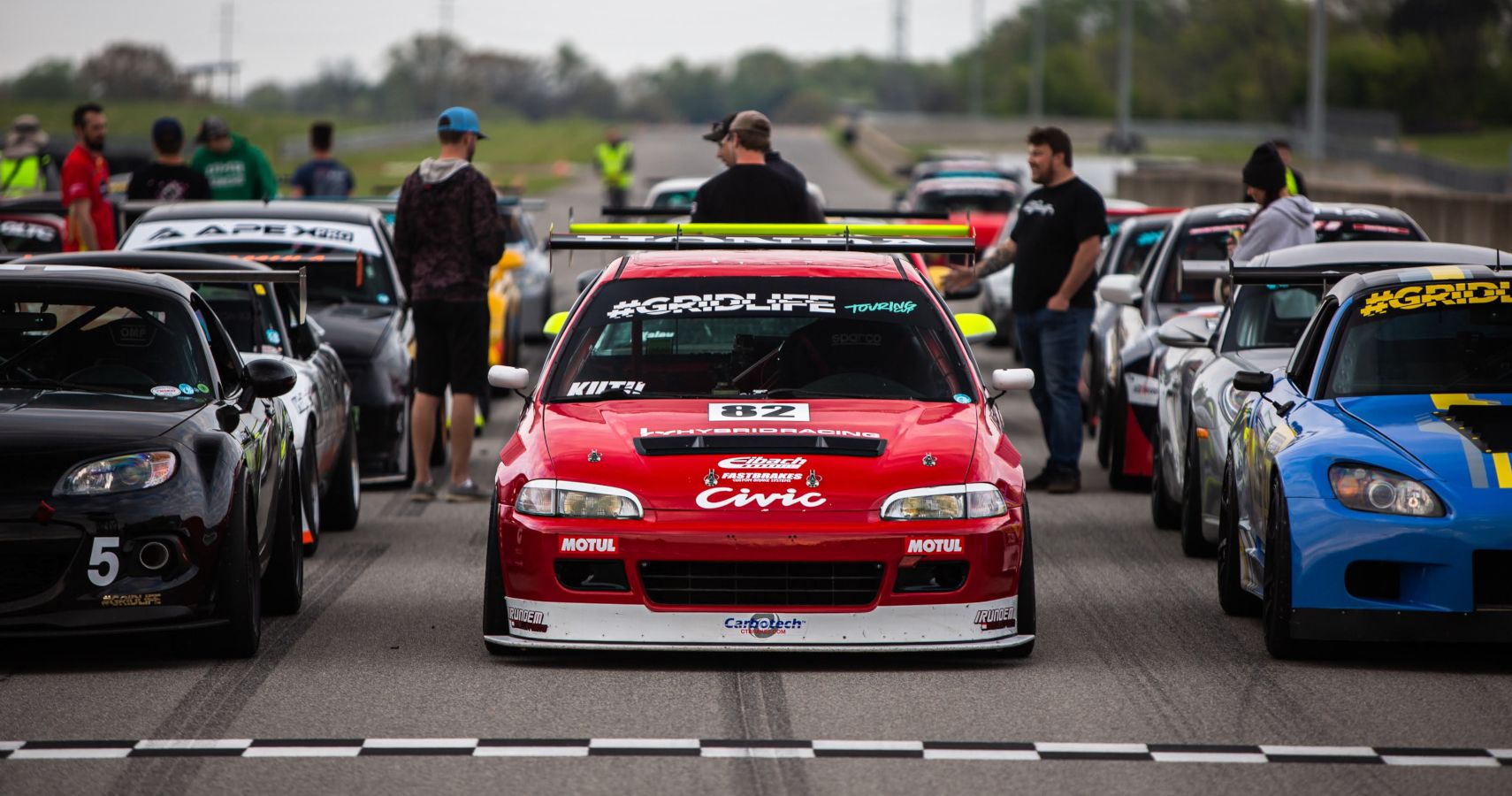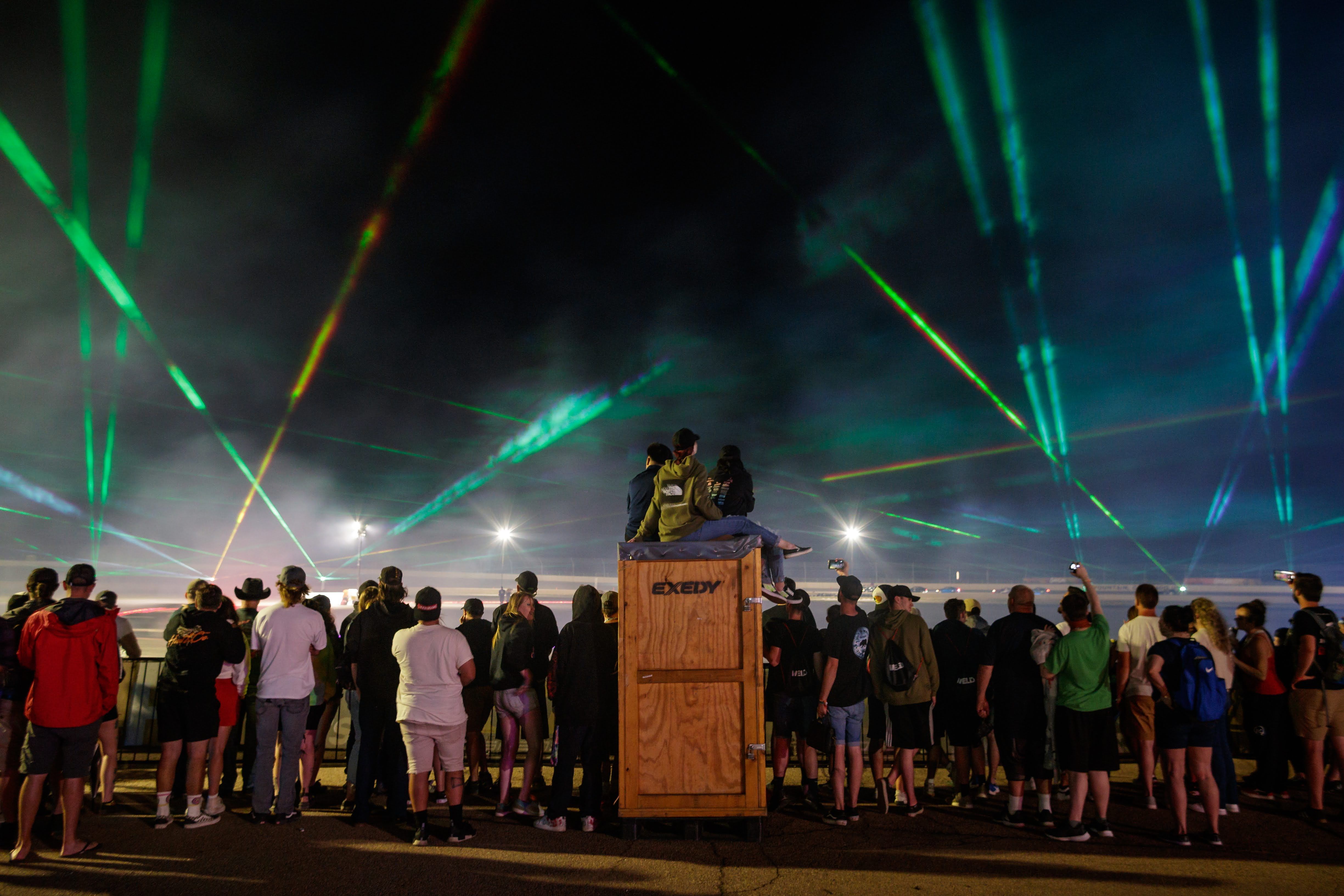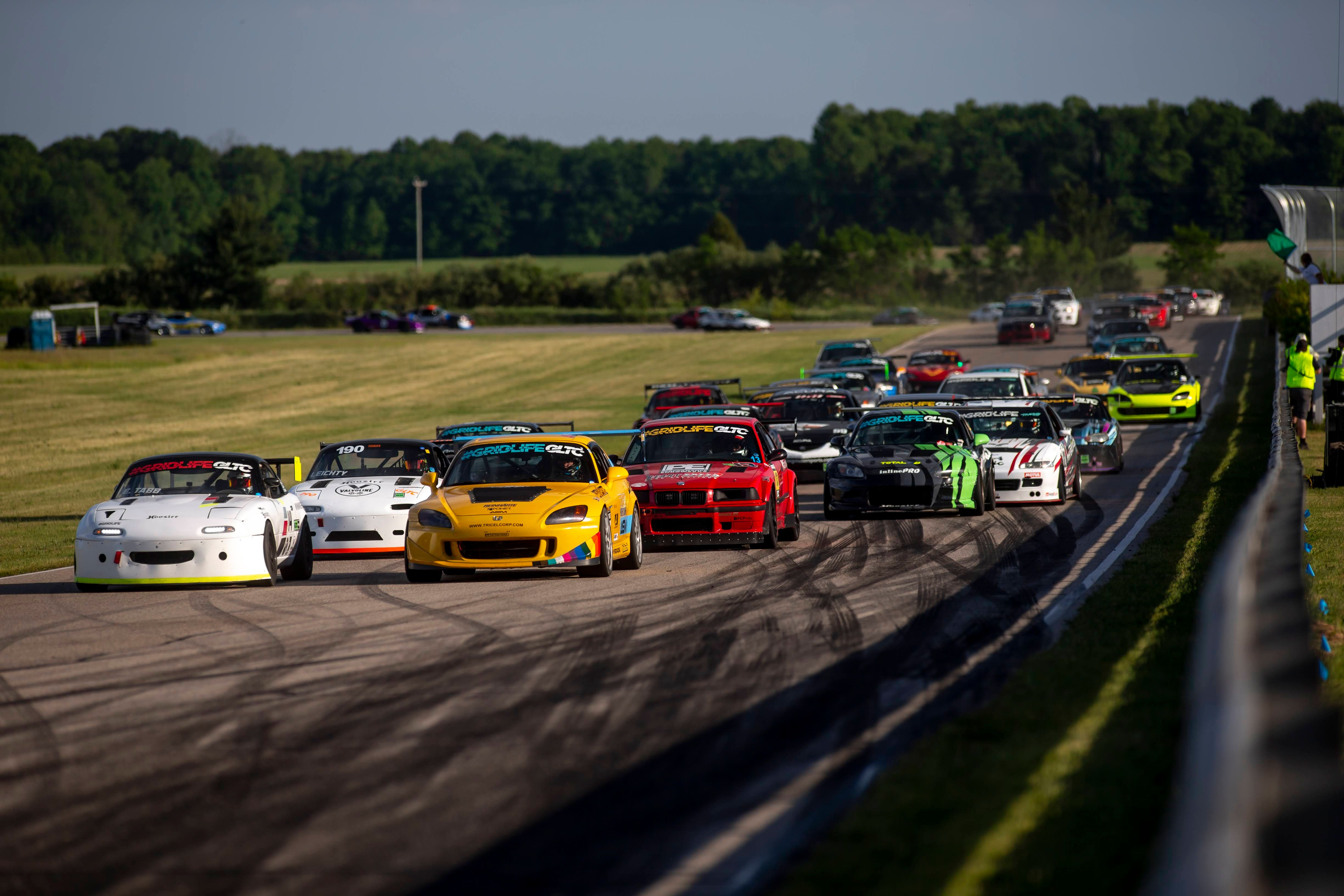It's hard to go racing.
You need a car that you're willing to risk, and you're going to eat tires. At the track, it can be a hostile insider's club that doesn't welcome newcomers (drag racing is an exception). There's less media coverage, race tracks are closing all over, and the motorsports landscape needs to change in order to survive.
But there's a rising star in the scene that's trying to wipe away every excuse to not take your car to a track day, or even go racing wheel to wheel. While some groups gatekeep the racing world and refuse to adapt, a few are embracing change and innovation. GRIDLIFE, founded in 2013, is all-in on the latter.
GRIDLIFE isn't just a race series, or a club that hosts track days or race weekends: It holds full-on automotive events and festivals complete with car shows, vendors, drifting, time attack, wheel-to-wheel racing, and live music. Instead of getting caught up in the hurdles of pro racing and sky-high expenses, GRIDLIFE focuses on accessibility and inclusivity for all who attend.
The show runners are in it simply to celebrate a shared passion for sports cars and racing. We had the opportunity to talk with the minds behind GRIDLIFE to learn about what the organization stands for and where it's going.
Making Motorsports Welcoming
The difference with GRIDLIFE starts with its core goal. Adam Jabaay, Motorsports Director and Cofounder, says the mission is, "Motorsports inclusion: Welcoming as many people, with a huge variety of cars (on and off the track), to the racetrack to celebrate the hobby we love, together." There are no sports dads pushing their kid to become the next F1 star, or heated ego battles turned to fistfights a la NASCAR in the paddock.
Instead of manufacturing rivalries and placing cars and drivers on a pedestal, GRIDLIFE focuses on cars and community. Check its social channels, watch its livestreams, or visit an event in person, and the difference quickly becomes obvious. Since its beginnings almost ten years ago, those priorities haven't changed.
GRIDLIFE's first event took place in 2014, bur pieces began taking shape much earlier. Adam explained:
"Chris Stewart and myself had been hosting events at Gingerman Raceway (simple HPDE weekend events, the West Michigan Honda Meet, which we still host) since 2004.
Between the two of us, we had friends all across the car and bike world with different interests. Car show buddies, parking lot meet buddies, autocross friends, drift friends, club racing pals, HPDE buddies, moped gangs, et c..
None of them hung out with each other much, and it was Chris' idea to throw a party at a track for everyone. Music was kind of the glue, too, and one of the things that separated it from a regular track event.
2014 was the first year, and it was different and fun, and it kept growing and evolving. We took the festival concept to Road Atlanta, Pikes Peak International Raceway, Lime Rock, and now it's a bit of a touring thing this year.
Over the past decade our time attack has grown from an informal event on track to what it is today, a competition environment we're very proud to present. And GRIDLIFE Touring Cup (GLTC) has been a big part of the growth in effort in presenting it, as well."
10 Years Of Festivals And Car Celebrations
Building the GRIDLIFE brand wasn't easy. Adam recalled that, "At first, other tracks and people in the sport didn't take us seriously. But that changed eventually. Insurance was a steep learning curve and is always a changing landscape. Developing processes, training teams up, and generally growing a business from a basement operation into a real thing without a huge sum of start up money—those things are hard in any business and this was and is no exception."
Shawn Fenton, Strategy Director, compared the small beginnings to today: "This year's Midwest Festival marked the 10th anniversary of the event. That event has grown over ten years to hosting 22,000 people over the course of the weekend. I'm not even sure how many were there in year one. Less than 1,000?"
In the early days of GRIDLIFE, they loaded up Founder and Director Chris Stewart's Honda Street 600 Kei Van on a trailer and brought that to the events as the operations hub. Away from the tracks, they worked out of Chris's basement.
Now they fill up a semi truck and trailer for events, and operate out of a 20,000 sq.ft. warehouse that they turned into a car club.
GRIDLIFE made its successes clear over the last decade, boasting climbing numbers in participation, fan attendance, and one of the best live stream productions you'll find in amateur racing today.
A lot of this is due to the attitude of inclusivity and a welcoming environment, but a good attitude only makes a difference with effective execution: "Presenting amateur motorsports in a way that seems approachable and relatable has been a huge goal since early on," Adam said.
"My personal goals and efforts [were] classes designed around people being able to build cars they wanted to build and daydreamed about, tracks people dream about driving, and a paddock culture that is a place people feel welcome and supported by each other and the organizations.
Building the event series I daydreamed about, from an on-track perspective and paddock nightlife angle, that's been my personal endeavor since we decided to do more than the first event."
The GRIDLIFE team had the concept mapped out with the types of cars, tracks, and lifestyle event angle. Over time, the people came.
Accessible And Affordable Racing
GRIDLIFE's appeal is how it's knocked down barriers that keep a lot of potential participants away from motorsports. This meant relatively affordable racing, and a new take on the racing class structures. In terms of cost, "Our partners, sponsors, and spectators really help us on that side," Adam said, "But it's a fight, especially with rapidly rising rates to rent tracks and to move our events around the country."
The organization also maintains rule sets to control cost, including 200-treadwear tire requirements and simplified power-to-weight classing (with some modifiers). They even host a "Sundae Cup" class that allows cars with a stock power to weight ratio of 25:1, like the Honda Fit, Ford Fiesta, and Mazda 2. The result is competitive, cost-effective, and fun, to drive and watch.
Keeping Racing Fun
No matter the challenges of evolving cars, rule-bending, and the never-ending tire wars, the GRIDLIFE team hangs onto keeping things fun. The GRIDLIFE Touring Cup (GLTC) motto is, "Race for the racing, not the result." This class of wheel-to-wheel racing allows cars built to 12.5 lbs/horsepower with weight percentage modifiers for aero, drivetrain, and other modifications. But here's the kicker: All of GLTC is just one racing class.
This is uncommon in the grassroots racing world, as you'd normally find one run group comprising up to five or six simultaneous racing classes. GLTC aims for something completely different: "It's a core piece of the design and probably the success of the class," Adam said.
"We really want everyone watching to know that everyone participating is racing each other...My wife was watching me compete in another sprint racing series, pre-GRIDLIFE, and said, 'I really wish I knew who you were racing against, why can't everyone be in the same class?'"
This concept worked, as GLTC regularly pulls forty to fifty car fields. Spectators don't have to guess who's leading, and the racers always have someone to battle against.
If racing isn't your thing, there's plenty to do at GRIDLIFE events off the track, with music, show cars, food, and vendors. There's also drifting, which always draws an audience, especially when the big names come out to play. Shawn recalled, "Ryan Tuerck was the first pro-drift driver to come to Midwest Festival. Chris just messaged him on Facebook and he showed up. Amazing. Now we have 90 drift cars...."
If you want to give it a shot yourself, GRIDLIFE makes every step of the racing ladder available to you. They host high performance driving experiences (HPDEs) for non-competition track time, or you can jump into the competition events if you have a legal car and enough experience. Either way, the team is working tirelessly to help the scene and get others involved.
Adam told us,
"We're not always sure where we'll be the next year, geographically. But whatever tracks we host with, we want to be building the surrounding car culture. Being an event that takes from other events is never a goal, it's actually the goal to do the opposite. We want the areas we host events in to have more enthusiasts who see the racetrack as home after every event. Showing a young car-curious person the path to getting on track, in person or on our livestream or on podcasts, or at least making the track a great place to hang out and enjoy the company of like-minded people, won't stop. Building a good schedule is always a task, and we'll keep striving for new fun venues."
GRIDLIFE's Future: New Venues, New Events, Same Passion
This year, GRIDLIFE makes the trek to the West coast for a new addition to the festival calendar. The team started talks with Weathertech Laguna Seca back in 2019, but unfortunately the pandemic and other issues threw the plan off. But in October of this year, GRIDLIFE will debut at the world-renowned track without sound limits for the competition days, a rare opportunity at this track.
There's also a joint weekend with NASCAR and Porsche Carrera Cup in July at Road America, for time attack and wheel-to-wheel racing. Adam says,
"It was an honor to be asked to participate in that event, and the main goal is to put on a good show for spectators with cars that they can relate to (and that they might have sitting in the garage!). We'll have a single rungroup of time attack with a fun variety of cars, and one of the largest rungroups GLTC ever to take to the track. We're really excited to bring our arcade out as well for those spectators wanting to do some gaming. We hope to bring a lot of our midwest friends out as well, and the track has given us multiple areas for our crowd to park and meet up. We're really looking forward to being back at Road America as well, as our date fell on the repave last year. Our drivers are really buzzing about the opportunity and we're planning for them to have a great experience there, as it's really about that. 'Best weekend ever' is the main goal, as with any event we do."
GRIDLIFE doesn't have the history in racing circles that other long-established racing organizations do, but it's come up to speed quick. As it turns out, focusing on fun and accessibility brings the crowd. In order to keep our automotive passion alive, we should strive to keep people excited about it and able to participate in any way possible.
Once people stop caring, the whole car scene suffers. Recognizing this danger, Adam lays out the future of GRIDLIFE: "The main product we produce is smiles and fistbumps, so the most possible smiles and fistbumps we can create is the future."









